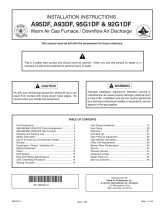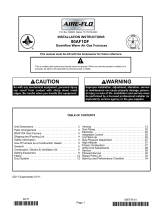
Page 6
D The gas cock must be T handle" type.
D When a furnace is installed in an attic, the passage-
way to and service area surrounding the equipment
shall be floored.
WARNING
Product contains fiberglass wool.
Disturbing the insulation in this product during
installation, maintenance, or repair will expose you
to fiberglass wool. Breathing this may cause lung
cancer. (Fiberglass wool is known to the State of Cal-
ifornia to cause cancer.)
Fiberglass wool may also cause respiratory, skin,
and eye irritation.
To reduce exposure to this substance or for further
information, consult material safety data sheets
available from address shown below, or contact your
supervisor.
Lennox Industries Inc.
P.O. Box 799900
Dallas, TX 75379−9900
Combustion, Dilution & Ventilation Air
In the past, there was no problem in bringing in sufficient out-
door air for combustion. Infiltration provided all the air that
was needed. In today’s homes, tight construction practices
make it necessary to bring in air from outside for combus-
tion. Take into account that exhaust fans, appliance vents,
chimneys, and fireplaces force additional air that could be
used for combustion out of the house. Unless outside air is
brought into the house for combustion, negative pressure
(outside pressure is greater than inside pressure) will build
to the point that a downdraft can occur in the furnace vent
pipe or chimney. As a result, combustion gases enter the liv-
ing space creating a potentially dangerous situation.
In the absence of local codes concerning air for combus-
tion and ventilation, use the guidelines and procedures in
this section to install SL280DFV furnaces to ensure effi-
cient and safe operation. You must consider combustion air
needs and requirements for exhaust vents. A portion of this
information has been reprinted with permission from the
National Fuel Gas Code (ANSI-Z223.1). This reprinted ma-
terial is not the complete and official position of the ANSI on
the referenced subject, which is represented only by the
standard in its entirety.
CAUTION
Do not install the furnace in a corrosive or contami-
nated atmosphere. Meet all combustion and ventila-
tion air requirements, as well as all local codes.
CAUTION
Insufficient combustion air can cause headaches,
nausea, dizziness or asphyxiation. It will also cause
excess water in the heat exchanger resulting in rust-
ing and premature heat exchanger failure. Excessive
exposure to contaminated combustion air will result
in safety and performance related problems. Avoid
exposure to the following substances in the combus-
tion air supply:
Permanent wave solutions
Chlorinated waxes and cleaners
Chlorine base swimming pool chemicals
Water softening chemicals
De-icing salts or chemicals
Carbon tetrachloride
Halogen type refrigerants
Cleaning solvents (such as perchloroethylene)
Printing inks, paint removers, varnishes, etc.
Hydrochloric acid
Cements and glues
Antistatic fabric softeners for clothes dryers
Masonry acid washing materials
All gas-fired appliances require air for the combustion pro-
cess. If sufficient combustion air is not available, the fur-
nace or other appliances will operate inefficiently and un-
safely. Enough air must be provided to meet the needs of all
fuel-burning appliances and appliances such as exhaust
fans which force air out of the house. When fireplaces, ex-
haust fans, or clothes dryers are used at the same time as
the furnace, much more air is necessary to ensure proper
combustion and to prevent a downdraft. Insufficient air
causes incomplete combustion which can result in carbon
monoxide.
In addition to providing combustion air, fresh outdoor air
dilutes contaminants in the indoor air. These contami-
nants may include bleaches, adhesives, detergents, sol-
vents and other contaminants which can corrode furnace
components.
The requirements for providing air for combustion and ven-
tilation depend largely on whether the furnace is installed in
an unconfined or a confined space.
Unconfined Space
An unconfined space is an area such as a basement or
large equipment room with a volume greater than 50 cubic
feet (1.42 m
3
) per 1,000 Btu (.29 kW) per hour of the com-
bined input rating of all appliances installed in that space.
This space also includes adjacent rooms which are not
separated by a door. Though an area may appear to be un-
confined, it might be necessary to bring in outdoor air for
combustion if the structure does not provide enough air by
infiltration. If the furnace is located in a building of tight
construction with weather stripping and caulking around
the windows and doors, follow the procedures in the air
from outside section.





















